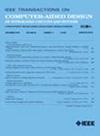Neural Evolutionary Architecture Search for Compact Printed Analog Neuromorphic Circuits
IF 2.7
3区 计算机科学
Q2 COMPUTER SCIENCE, HARDWARE & ARCHITECTURE
IEEE Transactions on Computer-Aided Design of Integrated Circuits and Systems
Pub Date : 2024-12-31
DOI:10.1109/TCAD.2024.3524357
引用次数: 0
Abstract
Printed electronics (PEs) is an additive fabrication technology which not only allows for a highly flexible printing of circuit patterns, but also produce soft, nontoxic, and degradable electronics at an extremely low cost. These properties make PE an enabler of new application domains, e.g., fast moving consumer goods and disposable healthcare devices. A particularly promising class of circuits in this technology is the printed analog neuromorphic circuits, offering efficient and highly tailored computational functionalities. In this work, we leverage the highly flexible fabrication process of PE to address the bottleneck of PE, i.e., the large feature sizes and low device counts. This issue is crucial, as it impairs the integration of printed circuits into target applications with limited footprint, such as smart band-aids. We propose an evolutionary algorithm (EA) to improve the circuit compactness through circuit architecture optimization. As baseline, we compare the proposed EA method with a state-of-the-art pruning method and a modified area-aware pruning method. All of them are able to optimize circuit architecture. Experimental simulation reveals that the proposed EA approach can effectively achieve compact circuits and outperform the pruning method by紧凑型印刷模拟神经形态电路的神经进化架构搜索
印刷电子(PEs)是一种增材制造技术,它不仅可以高度灵活地印刷电路图案,而且还可以以极低的成本生产柔软、无毒和可降解的电子产品。这些特性使PE成为新应用领域的推动者,例如快速消费品和一次性医疗保健设备。在这项技术中,一个特别有前途的电路是印刷模拟神经形态电路,提供高效和高度定制的计算功能。在这项工作中,我们利用PE的高度灵活的制造工艺来解决PE的瓶颈,即大特征尺寸和低器件数量。这个问题是至关重要的,因为它损害了将印刷电路集成到具有有限足迹的目标应用程序中,例如智能创可贴。我们提出一种进化算法(EA),通过优化电路结构来提高电路的紧凑性。作为基线,我们将提出的EA方法与最先进的修剪方法和改进的区域感知修剪方法进行比较。它们都能够优化电路结构。实验仿真表明,该方法可以有效地实现紧凑的电路,并且在不损失精度的情况下,比剪枝方法的面积小3.1倍。作为副产品,电力减少了3.0倍,为能量收集印刷系统铺平了道路。
本文章由计算机程序翻译,如有差异,请以英文原文为准。
求助全文
约1分钟内获得全文
求助全文
来源期刊
CiteScore
5.60
自引率
13.80%
发文量
500
审稿时长
7 months
期刊介绍:
The purpose of this Transactions is to publish papers of interest to individuals in the area of computer-aided design of integrated circuits and systems composed of analog, digital, mixed-signal, optical, or microwave components. The aids include methods, models, algorithms, and man-machine interfaces for system-level, physical and logical design including: planning, synthesis, partitioning, modeling, simulation, layout, verification, testing, hardware-software co-design and documentation of integrated circuit and system designs of all complexities. Design tools and techniques for evaluating and designing integrated circuits and systems for metrics such as performance, power, reliability, testability, and security are a focus.

 求助内容:
求助内容: 应助结果提醒方式:
应助结果提醒方式:


